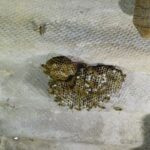How Do Wasps Make Their Nest?
Whenever you visit a tree, look into a window, or even see a wasp nest, you may wonder, “How do wasps make their nest?” Wasps are an important part of nature, and the construction of their nests is part of their life cycle.
A wasp nest is constructed from a combination of wood pulp and wasp saliva. The wasps use this mixture to form a network of walls, similar to a paper nest. Some wasps also use mud to help strengthen the structure.
The queen of the wasp colony starts construction of the nest in spring. The queen then searches for wood fibers that she can chew and scrape with her jaws. These wood fibers are chewed and mixed with saliva to make a paste. Then the queen and worker wasps add more wood fibers and paper pulp to make a hexagonal cell.
The nest is often constructed in a sheltered area. These places include the eaves of buildings and porch ceilings. The nests are usually a papery construction with hexagonal cells.
The nests vary in size, and each nest has a unique appearance. They can be found in the roofs of buildings, in chimneys, or even in wall cavities. The wasps often build their nests in the eaves of barns. They are also common in chimneys and second floor windows.
When the weather gets colder, the workers die. The remaining females then emerge as new queens. These queens start the cycle all over again, with new queens choosing a new nesting site.








